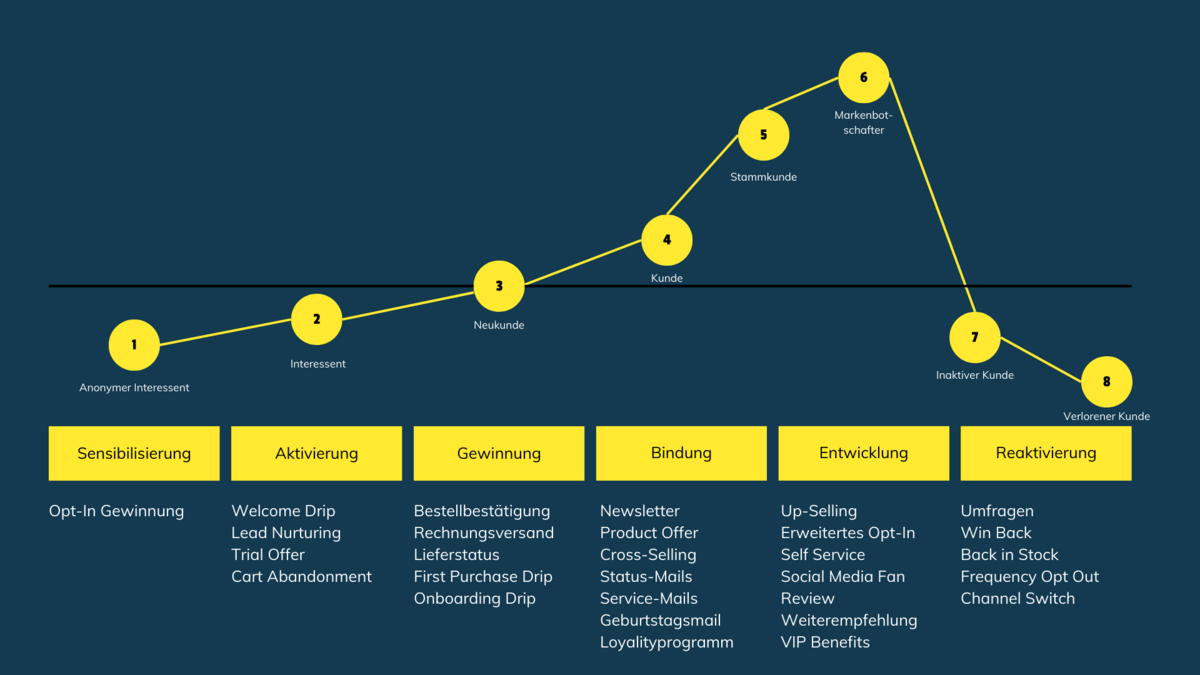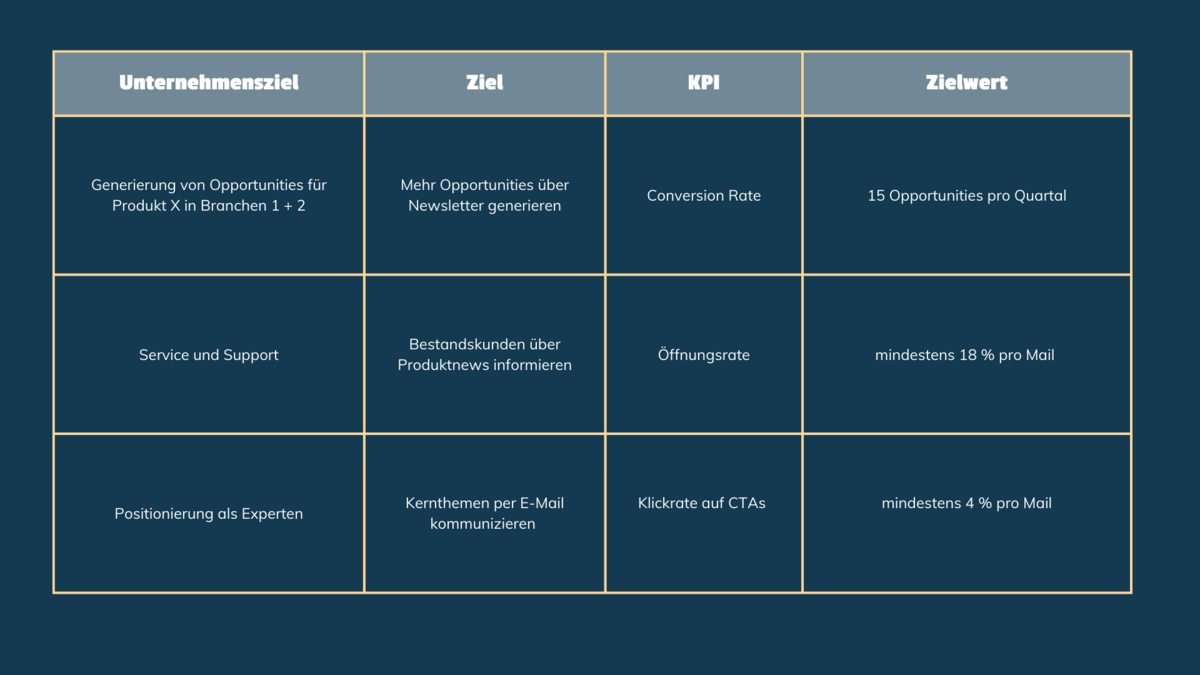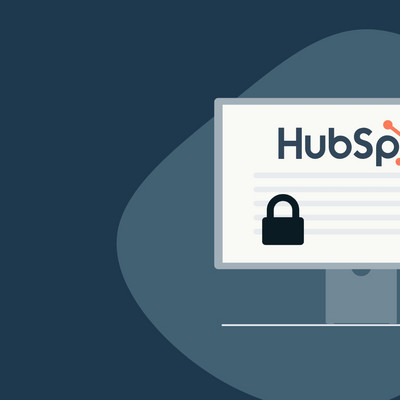Newsletter marketing is not a trivial discipline: you need to capture and understand your own target group as well as possible. Relevant content should be delivered at the right time. And you also need to create attractive layouts and encourage people to open them with compelling subject lines. On top of this, there are the technical and legal challenges, particularly in terms of data protection. Newsletter emails must not "scream" for automation - at the latest then they will end up unread in the spam folder.
This all sounds far too complex for you? Understandable, but you shouldn't do without email marketing - here you can find out what advantages it offers and how to use it effectively.
Why is newsletter marketing important?
Email marketing is part of content marketing - and therefore plays a central role in the digital marketing strategy of B2B companies in particular. It is a direct, low-cost method of retaining new and existing customers in the long term and supporting entire customer lifecycles.
In principle, five strategic goals can be identified for newsletter marketing:
- Retain new customers (prepare for conversions)
- Serve (existing) customers
- Deliver added value in the form of service and information
- Position yourself as an expert, gain influence
- Generate website traffic, raise brand awareness, increase reach
The newsletter is therefore a classic method for communicating with your target group in a targeted manner, building customer relationships and promoting your business success in the long term.
The little 1x1 of a successful newsletter strategy - 5 tips
How do I achieve high open and click rates as a company? What is my target group really interested in? These are typical questions that arise in newsletter marketing. There is no "secret solution" for all points, but here are three approaches that we strongly recommend:
This raises the question of who you are marketing your newsletter to. Your database provides an indication of this:
- Which people are in it or which email addresses do you have (you can collect email addresses via double opt-in forms, e.g. on your website)?
- Are there users among them that you would like to/must exclude, e.g. competitors?
- What information is available about the people, do you know anything about their interests?
- Can you track the activities of the individual persons, e.g. page visits?
- Can the data - if available - be structured and filtered, possibly by industry, number of companies or similar?
Segmenting groups of people (e.g. into group A, B, C ...) helps you to clarify which content is relevant for whom. A possible classification of contacts can also be made based on the "action phase" they are currently in. The following graphic, for example, shows which type of content can be used in which phase of the customer life cycle:
As you can see above, the content should not only provide information about your company, but primarily offer added value for your readers or subscribers. It is important to define which topics might interest them at which point in their customer journey. For example, provide checklists, entertaining videos, surveys or discounts.
When it comes to visual design, make sure you have a clear, user-friendly structure that allows your readers to easily grasp and navigate the content. Highlight important information, choose a harmonious color palette that matches the brand identity and enhance the text with high-quality images and graphics. Keep it short and sweet, even with videos. Responsive design is essential to ensure that the newsletter is displayed optimally on different devices and screen sizes. Further tips:
- Short, concise blocks of text, divided by meaningful headings (for better scannability)
- Personalization, for example by addressing them by name
- Catchy, strategically placed call-to-action buttons
If your newsletter is frequently not being delivered, you should definitely look into the reasons for this and investigate where the spam filter is taking effect. This means monitoring the reputation of your emails: This refers to the evaluation of integrity and seriousness by systems. It is made up of the evaluation of the domain, the content and the IP address of the sender. A poor reputation in one of these areas, whether due to a high spam rate or the frequent occurrence of bounces (undeliverable emails), can lead to your emails being automatically marked as spam in the future and no longer ending up in recipients' inboxes. To avoid this, you should:
- Craft the content of your emails carefully - and avoid words that are frequently used in spam emails, such as "free", "free of charge", "free", "limited offer", "exclusive", "guaranteed" or "free".
- make sure there is an unsubscribe link so that there are fewer spam complaints
- strengthen the authenticity of your domain and IP address through verification procedures such as SPF (Sender Policy Framework), DKIM (DomainKeys Identified Mail) and DMARC (Domain-based Message Authentication, Reporting & Conformance) and provide the necessary legal information
- subscribe to feedback loops with ISPs to be informed when recipients mark your emails as spam
- Reduce your sending frequency if necessary
- Reduce bounce rates by regularly removing undeliverable email addresses from your lists
Measuring and correctly analyzing the success of newsletter campaigns is crucial. This is the only way to find out which content works why, how and with whom. Without data-supported alignment of your email marketing strategy, you as a company could in the worst case lose reach, miss out on sales potential or lose leads and also lose an overview of the profitability of your efforts.
The aim of all evaluations - whether they are target-based, content-based or technically oriented - is to identify the need for optimization. There are some tried and tested methods here, such as A/B testing, which compares individual elements of the mail and sees which version "wins". These are, for example, elements such as layouts, subject lines etc.Before you can measure and evaluate campaign success at all, however, you need key figures that are really meaningful for your company. A "framework" for this could look like this, for example:
Evaluating the significance of KPIs correctly is tricky, but very important - for example, opening an email does not mean that it has been read. Some programs equate opening with loading the tracking pixels. However, this only starts if the client used allows image displays at all - which is often not the case. Professional email marketing tools such as HubSpot therefore also take other factors into account, such as clicks on tracked links.
Furthermore, bounces are normal to a certain extent. However, a high unsubscribe rate could mean that you are sending your newsletter too frequently or that its content is not relevant enough for your target group. A high spam rate is also critical - does your mail appear dubious? If so, this not only damages the delivery rate, but in the worst case also your reputation. The most important and meaningful key figure is almost always the click rate, as it provides information about the interests of your recipients.
Conclusion: Newsletter marketing - challenging but rewarding
Newsletter marketing is a multi-faceted strategy that provides your interested contacts with relevant offers and can therefore build the influence and reach of your company in the long term. Of course, the best way to learn how to deal with strategic, content-related and technical challenges is directly from practice: by continuously analyzing your campaigns, gathering feedback and adapting your strategies accordingly. This way, you can ensure that your content resonates and that you reach your target group effectively.





